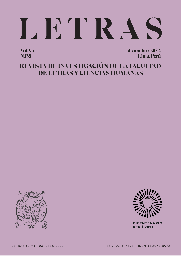Formas discursivas en la prensa popular peruana en la década de 1990
DOI:
https://doi.org/10.30920/letras.93.138.9Palabras clave:
Prensa popular, Semiótica, Semiopragmática, Enunciación, RecepciónResumen
En la década de 1990, en el Perú la llamada prensa popular, prensa sensacionalista o prensa chicha extendió su presencia en el espacio comunicacional de modo notable. Si bien ello se vio entonces ligado a relaciones de presión y de clientelismo con el gobierno de Fujimori, la presencia de esta prensa se observa aún hoy. Nuestra investigación aborda desde una perspectiva semiótica las características enunciativas que se fueron consolidando en ese período. Antes que un análisis de contenido, la investigación emprende una descripción de las estrategias enunciativas en juego con el fin de poder bosquejar a través de ellas el contrato de lectura informativo que se configuró. Seguimos para ello el enfoque semiótico de entender la enunciación como una representación: una enunciación enunciada. A partir de un corpus establecido con los diarios más leídos de dicho período (Ojo, Extra y Ajá), hemos buscado señalar la tipología textual frente a la que se situó al lector y las formas enunciativas que configuraron dentro de dichas manifestaciones. El estudio ha permitido establecer la presencia manifiesta de un género textual particular consolidado desde mediados del período estudiado, la columna de chismes, en las secciones de deportes y espectáculos, así como una presencia mayor de la entrevista.
Referencias
Arrunátegui, C. (2010). Ideología y prensa escrita en el Perú: el caso Bagua. Lexis, 34(2), 353-368. https://doi.org/10.18800/lexis.201002.005
Bourdieu, P. (1979). La distinction: critique sociale du jugement. Les éditions de minuit.
Cappellini, M. (2004). La prensa chicha en Perú. Chasqui, Revista Latinoamericana de Comunicación, 88, 32-37. https://revistachasqui.org/index.php/chasqui/article/view/282
Casas, R. (2009). La prensa chicha: un análisis cognitivo. Letras, 80(115), 63-85. https://doi.org/10.30920/letras.80.115.6
Conaghan, C. (2002). Cashing in on Authoritarianism: Media collusion in Fujimori’s Peru. The Harvard International Journal of Press Politics, 7, 115-125. https://doi.org/10.1177/1081180X0200700108
Courtés, J. (1997). Análisis semiótico del discurso: del enunciado a la enunciación. Gredos.
Courtés, J. (2003). La sémiotique du langage. Nathan Université.
Charaudeau, P. (2003). El discurso de la información. Gedisa. Charaudeau, P. (2015). De la “scène d’énonciation” au “contrat” et aller-retour. En Angermuller, J. y Philippe, G. (Dir.), Analyse du discours et dispositifs d’énonciation. Autour des travaux de Dominique Maingueneau (pp. 109-116). Limoges: Lambert-Lucas. http://www.patrick-charaudeau.com/De-la-scene-d-enonciationau.html
De Certeau, M. (1990). L’invention du quotidien. 1. Arts de faire. Gallimard.
Eco, U. (2008). Lector in fabula. Grasset.
Fontanille, J. (2003). Sémiotique du discours. [2.ª Ed.]. Presses Universitaires de Limoges.
Fontanille, J. (2008). Pratiques sémiotiques. Presses Universitaires de France.
Fowks, J. (2000). Suma y resta de la realidad. Medios de comunicación y elecciones generales 2000 en el Perú. Fundación Friedrich Ebert.
Fowks, J. (2015). Chichapolitik: la prensa con Fujimori en las elecciones generales 2000 en el Perú. Servicios Educativos Rurales, Fundación Friedrich Ebert.
Gargurevich, J. (1991). Historia de la prensa peruana (1594-1990). La Voz Ediciones.
Gargurevich, J. (1999). Los periodistas: Historia del gremio en el Perú. La Voz.
Gargurevich, J. (2002). La prensa sensacionalista en el Perú. Pontificia Universidad Católica del Perú.
Greimas, A. (1984). Sémiotique figurative et sémiotique plastique. Groupe de recherches sémio-linguistiques.
Hénault, A. (2012). Les enjeux de la sémiotique. Presses Universitaires de France.
Kerbrat-Orecchioni, C. (1997). L’énonciation. [3.ª Ed.]. Armand Colin.
Landowski, E. (2006 [2005]). Les interactions risquées. Nouveaux Actes Sémiotiques, 101, 102, 103.
Landowski, E. (2016). Presencias del otro. Fondo Editorial de la Universidad de Lima.
Lino, L. (2008). Naturalidad del racismo en la prensa sensacionalista. Escritura y Pensamiento, 10(22), 159-185. https://doi.org/10.15381/escrypensam.v11i22.7947
Macassi, S. y Ampuero, F. (2001). Prensa amarilla y cultura política en el proceso electoral. Asociación de Comunicadores Sociales Calandria-Centro de Investigación.
Maingueneau, D. (2014). Discours et analyse du discours. Armand Colin.
Maingueneau, D. (2016). Analyser les textes de communication. Armand Colin.
Martín Barbero, J. (1991). De los medios a las mediaciones. Comunicación, cultura y hegemonía. [2.ª Ed.]. Ediciones Gustavo Gili.
Mendoza Michilot, M. (2013). 100 años de periodismo en el Perú, 2 tomos. Fondo Editorial de la Universidad de Lima.
Montero, V. (2008). Análisis psicosocial del discurso de la prensa sensacionalista peruana y las actitudes de sus lectores. Revista de Investigación en Psicología, 11(2), 153-181. https://doi.org/10.15381/rinvp.v11i2.3846
Odin, R. (2011). Les espaces de communication. Grenoble: Presses Universitaires de Grenoble.
Pahuacho, A. (2014). El tópico sacrificial en los discursos de la prensa deportiva en el Perú. El caso del futbolista Paolo Guerrero. Correspondencias & Análisis, 4, 153- 175. https://doi.org/10.24265/cian.2014.n4.08
Villalobos, M. (2020). Los temas policiales y la violencia, los asuntos priorizados por el diario más exitoso de habla hispana. Desde el Sur, 12(1), 177-200. https://doi.org/10.21142/DES-1201-2020-0012
Wood, D. (2000) The peruvian press under recent authoritarian regimes, with special reference to the autogolpe of President Fujimori. Bulletin of Latin American Research, 19(1), 17-32. https://doi.org/10.1111/j.1470-9856.2000.tb00090.x
Zola, E. (2012). La fortune des Rougon. Gallimard.
Publicado
Número
Sección
Licencia
Derechos de autor 2022 Miguel Ángel Torres Vitolas

Esta obra está bajo una licencia internacional Creative Commons Atribución 4.0.






